Can industrial large vacuum electric furnaces be gas quenched?
 11-14-2025 Author: KJ technology
11-14-2025 Author: KJ technology
Industrial large-scale vacuum electric furnaces can be gas quenched, and vacuum high-pressure gas quenching technology has become a key process in the modern heat treatment field, especially suitable for high-end manufacturing scenarios with strict requirements for material properties. The following analysis is conducted from four dimensions: technical principles, process advantages, equipment support, and application scenarios:
1. Technical principle: Accurate gas quenching in vacuum environment
Vacuum high-pressure gas quenching is a branch of vacuum heat treatment technology, which focuses on heating metal workpieces in a vacuum environment to a specific temperature (such as 1100 ℃ or above for titanium alloys), completing tissue transformation, and then filling high-pressure inert gases (such as nitrogen, argon, or mixed gases) into the furnace to achieve rapid cooling of the workpiece through high-speed airflow. This process is carried out entirely in a clean vacuum atmosphere, and the cooling medium achieves precise control of different cooling rates through pressure regulation, which can meet the requirements of martensitic transformation and avoid the defects of traditional processes.
2. Technological advantages: triple guarantee of cleanliness, efficiency, and precision
Non oxidation treatment: The vacuum environment effectively eliminates impurities such as oxygen and water vapor in the furnace, achieving non oxidation and decarburization heating of the workpiece. After processing, the surface of the workpiece is bright and clean, without the need for subsequent polishing and other precision machining processes, especially suitable for the preparation of high-purity materials such as semiconductors and optical ceramics.
Enhancement of densification: Vacuum degassing can remove tiny pores inside the workpiece, significantly improving the density of the material. For example, after vacuum sintering, the density of hard alloy is higher, and the hardness and wear resistance are significantly improved.
Deformation control: Traditional quenching can easily cause deformation and cracking of the workpiece due to uneven cooling, while vacuum high-pressure gas quenching can evenly cool various parts of the workpiece by optimizing airflow circulation and pressure gradient. Especially for complex workpieces with thin walls and sharp corners, the cooling strategy of "low pressure start+gradual pressure rise" is adopted, and the deformation is only one-third of that of salt bath quenching.
Environmental protection and energy conservation: Compared to oil quenching process, gas quenching does not require quenching oil, avoiding oil pollution from the source and eliminating subsequent cleaning processes. Advanced gas quenching equipment is also equipped with a gas recovery system, which can significantly reduce the cost of inert gas consumption. At the same time, precise heating is achieved through a programmable temperature control system, reducing energy waste and meeting the green production needs of modern manufacturing industry.
3. Equipment support: Intelligent system with multi parameter collaborative control
The gas quenching function of industrial large-scale vacuum furnaces relies on highly integrated intelligent systems, whose core parameters include:
Temperature control: Adopting multi zone independent temperature control technology, the temperature field uniformity is ≤± 5 ℃, meeting the requirements of precision heat treatment process. For example, the intelligent vacuum high-pressure gas quenching heat treatment production line developed by Dingli Technology achieves 24-hour unmanned black light continuous production through a programmable temperature control system.
Vacuum degree adjustment: The vacuum system achieves a high vacuum environment (ultimate vacuum degree ≤ 5 × 10 ⁻ ³ Pa) to ensure zero oxidation conditions during material processing. The preheating stage adopts a lower vacuum degree, while the heating and insulation stage has a higher vacuum degree, generally selected between 10 ⁻¹ bar and 10 ⁻³ bar.
Gas parameter optimization: By adjusting the gas type (nitrogen, argon, helium, etc.), pressure (adjustable from 0.8-10bar), and flow rate (high flow rate for rapid cooling in the high-temperature section, and low flow rate for stress reduction in the low-temperature section), different material processing requirements can be achieved. For example, the cooling ratio of 10 bar low-temperature nitrogen is increased compared to 6 bar, and 20 bar is increased compared to 6 bar.
4. Application scenarios: covering the entire field from aerospace to precision manufacturing
Aerospace: Used for heat treatment of titanium alloy components and high-temperature alloy parts. For example, nickel based high-temperature alloys undergo solid solution strengthening treatment through vacuum high-pressure gas quenching to eliminate casting segregation defects; During the heat treatment of titanium alloys in the beta phase region, rapid gas quenching can control the precipitation morphology of the alpha phase and improve material properties.
Automotive industry: handling key components such as precision gears and molds. For example, after vacuum gas quenching, the hardness uniformity of mold steel is improved, the microstructure is uniform and fine, the residual austenite content is reduced, and the mold life is extended.
Medical devices: The heat treatment of stainless steel precision parts relies on the cleanliness of vacuum gas quenching. For example, after vacuum treatment, medical devices have no oxide layer on their surface and their biocompatibility is significantly improved.
In the field of energy, materials such as nuclear fuel and electrical materials that require high-purity environments are prepared. Vacuum gas quenching can avoid impurity contamination and ensure stable material performance.








